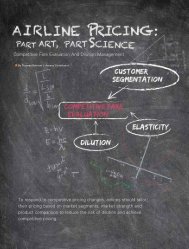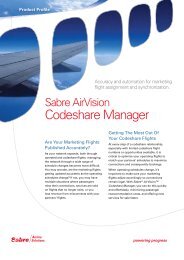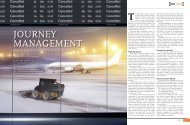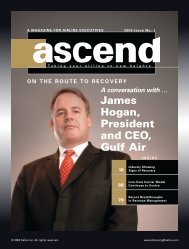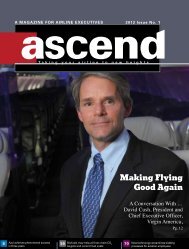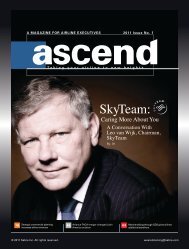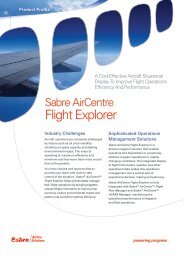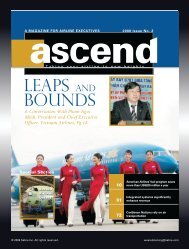2009 Issue 1 - Sabre Airline Solutions
2009 Issue 1 - Sabre Airline Solutions
2009 Issue 1 - Sabre Airline Solutions
You also want an ePaper? Increase the reach of your titles
YUMPU automatically turns print PDFs into web optimized ePapers that Google loves.
is to offer daily service in all markets and, in some<br />
cases, increase it to twice daily or even more,<br />
depending on market demand. Emirates offers<br />
service to most continents with extended-range<br />
operations with the B777-200LRs to São Paulo,<br />
Brazil, and Houston, Texas. As one of the launch<br />
customers for the A380, Emirates was finally able<br />
to deploy the aircraft type on high-frequency, highvolume<br />
routes to London Heathrow Airport and<br />
John F. Kennedy International Airport. As one of<br />
the world’s most profitable airlines, Emirates plays<br />
a major role in the Europe to Australia market and<br />
has aggressive plans to increase frequency and<br />
service in this market as well as continue to serve<br />
as a major feeder of traffic into the Indian subcontinent.<br />
On the heels of Emirates are Etihad and<br />
Qatar <strong>Airline</strong>s, which share a similar large order of<br />
wide-body aircraft and the desire to rival the larger<br />
neighbor in fleet size and network structure.<br />
The prolonged delay of the A380 program<br />
also had a substantial impact on Singapore <strong>Airline</strong>s,<br />
the global launch customer of the equipment type.<br />
In many cases, the carrier was forced to either<br />
temporarily increase frequency and/or maintain<br />
B747-400 operations on routes slated for the A380.<br />
Ultimately, Singapore <strong>Airline</strong>s plans to reduce the<br />
number of B747 in its fleet and supplement its<br />
operations with B777, A330 and A380 aircraft.<br />
Similarly to Emirates, Singapore has introduced the<br />
A380 on high-frequency, high-volume routes from<br />
its base airport to London Heathrow Airport, Tokyo<br />
Narita International Airport and Australia’s Sydney<br />
Airport.<br />
Qantas Airways has also introduced the<br />
A380 on its high-volume routes to Los Angeles<br />
from both Sydney and Melbourne, Australia, with<br />
the goal of offering daily service between the two<br />
city pairs. Interestingly, Singapore <strong>Airline</strong>s has opted<br />
to reintroduce A330s into its operating fleet, replacing<br />
some B777s on regional routes that were used<br />
almost a decade ago to replace the older A330s.<br />
+count it up<br />
3.2<br />
The percentage of estimated annual<br />
growth rate for aircraft in service<br />
between the years 2007 and 2027,<br />
according to Boeing.<br />
the economic downturn has also impacted low-cost carriers, such as jetBlue, which has<br />
opted to sell its older Airbus A320 aircraft while continuing to accept embraer e-190s to<br />
support its growth plans.<br />
Nonetheless, the airline is committed to the use of<br />
the B777 for international operations and has used<br />
them to replace older B747-400s.<br />
Although the immediate future for the global<br />
airline industry remains uncertain, one thing remains<br />
valid — there will be a residual demand for new<br />
aircraft rolling off the production lines, and carriers<br />
that have taken the necessary steps during the economic<br />
downturn will be well positioned to reap the<br />
benefits of the newly acquired resources. There will<br />
be rationalization in the Indian and Middle East markets,<br />
and U.S. major network carriers will have to<br />
face the reality of obtaining new aircraft to improve<br />
their operational efficiency and reduce fuel costs.<br />
Regardless of the future trends in fuel prices,<br />
airlines can actively control their fuel expenses either<br />
through fuel hedging and/or operating modern,<br />
more-efficient aircraft. In addition, these new aircraft<br />
will give carriers the flexibility to pursue new markets<br />
2027<br />
The year in which 82 percent of the<br />
industry’s fleet will be aircraft that do<br />
not exist today, according to Boeing.<br />
that result from recent market liberation and openskies<br />
agreements.<br />
As the world economy recovers from its current<br />
recession, passenger and cargo traffic levels will<br />
recover, and airlines will see the need to increase<br />
their flight schedules to serve the increasing traffic<br />
demand. The continued growth of global airline alliances<br />
will influence future fleet planning decisions as<br />
alliances reconcile their marketing strategies and<br />
realign key markets. a<br />
98<br />
Michael Clarke is director of optimization<br />
solutions in airline operations for <strong>Sabre</strong><br />
<strong>Airline</strong> <strong>Solutions</strong> ® . He can be contacted<br />
at michael.clarke@sabre.com.<br />
The percentage of accurate baggage<br />
handling of the 2.25 billion bags<br />
airlines handle each year. According<br />
to IATA, the 2 percent of mishandled<br />
bags leave 48 million passengers disappointed<br />
each year.<br />
ascend<br />
Photo courtesy of Embraer<br />
29<br />
industry



